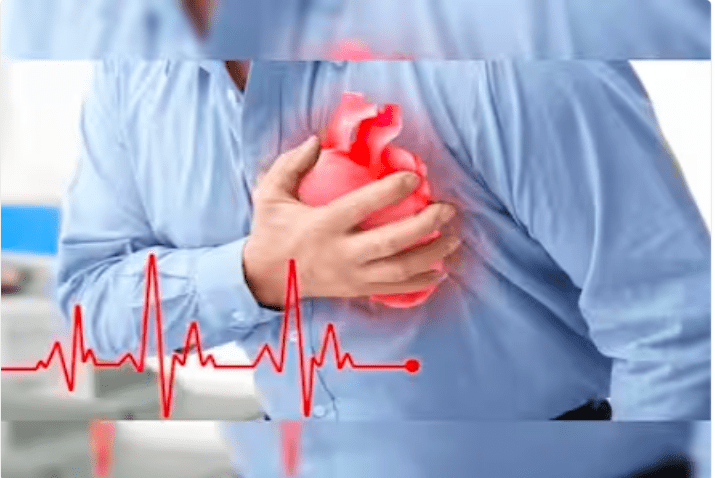Trending Stories
Recognizing Heart Attack Symptoms: More Than Just Chest Pain

Recognizing Heart Attack Symptoms: More Than Just Chest Pain
Heart attacks are commonly associated with intense chest pain, but what if we told you that there are other, lesser-known symptoms that could indicate a heart attack?
In a recent personal account published by The Washington Post, author Ken Budd shares his own experience of a heart attack and sheds light on the surprising indicators that could help save lives. By recognizing these early warning signs, you can take swift action and potentially prevent a catastrophic event.
Budd’s story begins with what he initially believed to be indigestion. However, his symptoms progressed beyond discomfort, leading to a series of alarming signals that he couldn’t ignore.
Days before experiencing chest pain, he noticed he was unusually breathless and sweaty after performing simple tasks. As the pain spread to his shoulder, neck, and back, Budd struggled to find relief and even woke up in the middle of the night covered in sweat.
Concerned due to his father’s history of sudden heart attacks, Budd decided to seek medical attention despite feeling hesitant.
The surprising revelation from Budd’s account is that heart attacks can manifest in various ways and are not always accompanied by severe chest pain.
Dr. Alan Schneider, a cardiologist at Suburban Hospital, emphasizes that individuals often experience discomfort rather than crushing pain.
Upper body pain, including shoulder and neck pain, can be an indication of an impending heart attack. Cardiologist Dr. Donald M. Lloyd-Jones further explains that any discomfort between the belly button and the forehead could be a symptom related to the heart.
Recognizing the signs of a heart attack is crucial, especially for Gen Xers like Budd, who may have grown up watching portrayals of chest-clutching heart attacks in popular culture.
However, as Budd discovered, the pain can be milder and may present as a feeling of pressure or discomfort, akin to having a weight on the chest or an overinflated sensation.
While chest pain remains the most common warning sign, it’s important not to overlook other potential indicators. Arm pain, typically on the left side, stomach pain, and even pain in the gums or jaw can all be red flags.
Women may experience more diffuse or vague symptoms, such as sudden arm aches, neck or jaw aches, nausea or vomiting, dizziness, or unusual fatigue.
It’s crucial to note that heart attack symptoms can appear hours, days, or even weeks in advance, as explained by the renowned Mayo Clinic. Dr. Lloyd-Jones advises that if symptoms worsen with exertion and improve with rest, it’s a clear signal to seek medical attention promptly.
Budd’s personal account emphasizes the importance of acting quickly in the face of potential heart issues. His initial hesitation and assumption that it might be nothing could have cost him his life.
Prompt action is essential, as time is of the essence when it comes to preserving heart muscle and preventing further damage.
Cardiologist Dr. Yuri Deychak stresses that the sooner blood flow and oxygen levels are restored, the better the chances of recovery. Ideally, a patient should reach a cardiac catheterization lab, where a stent can be inserted to unblock an artery, within 90 minutes of experiencing symptoms.
Budd’s story also highlights the significance of seeking medical help via the appropriate channels. While asking a friend to drive you to the emergency room may seem like a reasonable choice, it’s not as effective as calling 911.
Emergency Medical Technicians (EMTs) are equipped with the necessary tools, such as a defibrillator and an EKG machine, to provide immediate treatment in case of cardiac arrest
The Surprising Indicators and Early Warning Signs of a Heart Attack
When it comes to heart attacks, the common perception revolves around severe chest pain. However, there are several lesser-known indicators and early warning signs that should not be ignored.
Personal Account of a Heart Attack: An Eye-Opening Experience
In an eye-opening account shared by Ken Budd in The Washington Post, he recounts his personal experience of a heart attack and sheds light on these surprising symptoms that could potentially save lives.
By being aware of these signs, individuals can take proactive measures and possibly prevent a life-threatening event.
Budd’s journey began with what he initially believed to be a bout of indigestion. However, his symptoms progressed beyond mere discomfort, gradually manifesting into a series of alarming signals that demanded attention.
Days prior to experiencing chest pain, he noticed unusual shortness of breath and excessive sweating after performing simple tasks.
The discomfort then extended to his shoulder, neck, and back, making it difficult for him to find relief and even causing him to wake up drenched in sweat during the night.
Given his father’s history of sudden heart attacks, Budd decided to seek medical assistance despite feeling somewhat hesitant.
The intriguing aspect of Budd’s account lies in the fact that heart attacks can present themselves in various ways, often without the presence of intense chest pain.
Dr. Alan Schneider, a cardiologist at Suburban Hospital, stresses that individuals frequently experience discomfort rather than the crushing pain commonly associated with heart attacks.
Pain in the upper body, including the shoulder and neck, can be an indicative sign of an impending heart attack.
Cardiologist Dr. Donald M. Lloyd-Jones further explains that symptoms related to the heart can manifest anywhere between the belly button and the forehead, making it important to pay attention to any discomfort in these areas.
Recognizing the signs of a heart attack is of utmost importance, particularly for individuals belonging to Generation X, like Budd, who may have grown up witnessing dramatic portrayals of chest-clutching heart attacks in popular culture.
However, as Budd discovered, the pain experienced can be milder, often manifesting as a sensation of pressure or discomfort, as if a weight is pressing against the chest or the chest is excessively inflated.
While chest pain remains the most commonly known warning sign, it is crucial not to overlook other potential indicators. Arm pain, typically on the left side, stomach pain, and even pain in the gums or jaw can all serve as red flags.
Women, in particular, may experience more diffuse or vague symptoms, such as sudden arm aches, neck or jaw pain, nausea or vomiting, dizziness, or unusual fatigue.
It is important to note that heart attack symptoms can appear hours, days, or even weeks in advance, as highlighted by the renowned Mayo Clinic.
Dr. Lloyd-Jones advises that if symptoms worsen during physical exertion and improve with rest, it is a clear signal to promptly seek medical attention.
Budd’s personal account underscores the significance of acting swiftly when faced with potential heart issues. His initial hesitation and assumption that it might be nothing could have had dire consequences.
Time plays a critical role in preserving heart muscle and preventing further damage. Cardiologist Dr. Yuri Deychak emphasizes that the sooner blood flow and oxygen levels are restored, the greater the chances of recovery.
Ideally, patients should reach a cardiac catheterization lab, where a stent can be inserted to unblock an artery, within 90 minutes of experiencing symptoms.
REFERENCE
https://www.washingtonpost.com/wellness/2023/06/11/heart-attack-symptoms-shoulder-neck-pain/
Trending Stories
Sister Regina Liu: Empowering Health Through Acupuncture

Sister Regina Liu: Empowering Health Through Acupuncture
In the bustling world of healthcare, Sister Regina Liu stands out as a beacon of holistic healing. Her journey into the world of acupuncture is not only inspiring but also transformative for the countless individuals she has treated.
Through her dedication, Sister Regina has brought traditional Chinese medicine to the forefront, offering an alternative and complementary approach to modern medical practices.
The Journey of Sister Regina Liu
Sister Regina Liu’s path to becoming a renowned acupuncturist began with her deep-rooted interest in holistic health. Born into a family that valued traditional Chinese medicine, Sister Regina was exposed to the benefits of acupuncture from a young age. Her early fascination turned into a lifelong passion as she pursued formal education and training in the field.
Acupuncture: Bridging Ancient Wisdom and Modern Health
Acupuncture, a practice with origins in ancient China, involves inserting thin needles into specific points on the body to balance the flow of energy or “qi.” Sister Regina Liu has mastered this ancient art, using it to address a wide range of health issues.
From chronic pain to stress management, her expertise has provided relief to many who had exhausted conventional treatment options.
Impact on Community Health
Sister Regina’s impact extends beyond individual treatments. She has been instrumental in educating the community about the benefits of acupuncture, breaking down misconceptions, and making the practice more accessible.
Her workshops and seminars have enlightened many about the holistic approach to health, emphasizing the interconnectedness of body, mind, and spirit.
Success Stories and Testimonials
The success stories of Sister Regina’s patients are a testament to her skill and dedication. Many individuals who had lost hope found solace in her treatments.
For instance, Maria, a long-time sufferer of migraines, experienced significant relief after just a few sessions with Sister Regina. Her story is just one of many that highlight the transformative power of acupuncture under Sister Regina’s care.
Challenges and Triumphs
Like any journey, Sister Regina’s path was not without challenges. Integrating acupuncture into mainstream healthcare faced resistance initially.
However, her perseverance and the undeniable results of her treatments gradually won over skeptics. Today, Sister Regina is not only respected in the field of acupuncture but also in the broader medical community.
The Science Behind Acupuncture
While acupuncture is rooted in ancient practices, modern science has begun to unravel the mechanisms behind its effectiveness. Studies have shown that acupuncture can stimulate the release of endorphins, the body’s natural painkillers, and improve blood circulation.
These scientific validations have further cemented acupuncture’s place in contemporary healthcare, thanks in part to advocates like Sister Regina Liu.
Acupuncture in Modern Healthcare
Sister Regina’s work exemplifies how traditional practices can complement modern medicine. Hospitals and clinics increasingly incorporate acupuncture into their treatment plans, recognizing its benefits in pain management, mental health, and overall well-being. This integration signifies a broader acceptance and understanding of holistic health practices.
Future Vision
Looking ahead, Sister Regina Liu envisions a future where acupuncture and traditional Chinese medicine are fully integrated into the global healthcare system. She continues to advocate for research, education, and policy changes that support the inclusion of holistic practices in mainstream medicine.
How to Get Started with Acupuncture
For those new to acupuncture, Sister Regina offers practical advice on getting started. She recommends finding a certified acupuncturist, understanding the treatment process, and maintaining an open mind. Her guidance helps demystify acupuncture, making it more approachable for newcomers.
Conclusion
Sister Regina Liu’s journey in empowering health through acupuncture is a remarkable tale of dedication, resilience, and success. Her contributions have not only alleviated individual suffering but also enriched the broader understanding of holistic health. As acupuncture continues to gain recognition, Sister Regina’s legacy will undoubtedly inspire future generations of healers.
FAQs
1. What conditions can acupuncture treat?
Acupuncture can address various conditions, including chronic pain, migraines, stress, anxiety, digestive issues, and more. It is also used to support overall wellness and balance.
2. Is acupuncture safe?
Yes, when performed by a certified and experienced acupuncturist, acupuncture is safe. It involves using sterile, single-use needles and adhering to proper hygiene practices.
3. How many sessions are needed to see results?
The number of sessions varies depending on the condition and individual response. Some may experience relief after one session, while others may need multiple treatments.
4. Does acupuncture hurt?
Acupuncture needles are very thin, and most people feel minimal to no discomfort. Some may feel a slight tingling or warmth at the needle site.
5. How do I find a qualified acupuncturist?
Look for acupuncturists who are certified by recognized professional organizations and have positive patient reviews. Personal recommendations and consultations can also help in making an informed choice.
References
Trending Stories
In 2 Shape Gym Unveils Major Expansion in Stourport
Trending Stories
9 Reasons Why In-Person Friendships Are Irreplaceable
-

 Trending Stories1 year ago
Trending Stories1 year agoCDC: 1 in 4 Americans Still COVID-Free by End of 2022
-

 Health5 years ago
Health5 years agoMeghan Trainor Shares Motivational New Song ‘Blink’
-

 Health2 years ago
Health2 years agoHow Long Does Monkey Pox Last Before It Surfaces in the Body?
-

 Health2 years ago
Health2 years agoWhat Causes Swollen Body? Understanding Edema and its Triggers
-

 Health3 years ago
Health3 years agoNutrition and the Importance of a Fitness Program – 3 Things to Know
-

 Health3 years ago
Health3 years ago5 Weird Reasons Why Pimples Disappear After Marriage
-

 Health3 months ago
Health3 months agoHow Do Pawpaw Seeds Support Cardiovascular Health?
-

 Health2 years ago
Health2 years agoHealth Benefits Of Pawpaw Seed? 7 Things To Know







